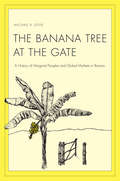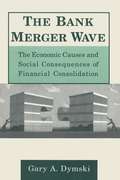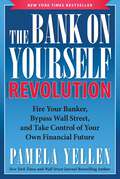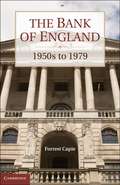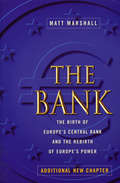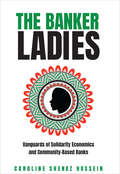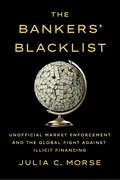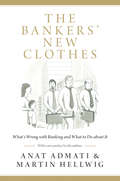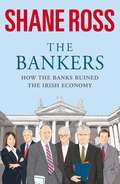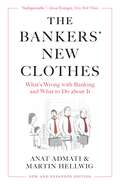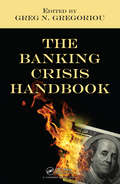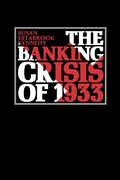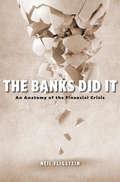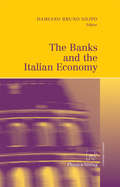- Table View
- List View
The Baltic Countries: Medium-Term Fiscal Issues Related to EU and NATO Accession
by International Monetary FundTen years after regaining independence, the three Baltic countries of Estonia, Latvia, and Lithuania are now fully functioning market economies. They are on the verge of acceding to the European Union (EU) and the North Atlantic Treaty Organisation (NATO), and this paper discusses the fiscal challenges they face in the run-up to the accession process.
The Baltics
by Stefania Fabrizio Robert Burgess Yuan XiaoThis paper assesses the competitive position of the Baltic countries of Estonia, Latvia, and Lithuania, in the light of their accession to the EU, focusing on the viability of maintaining fixed exchange rates upon joining the EU, participating in its exchange rate mechanism and adopting the euro currency. Issues discussed include: effective exchange rate indicators and export performance; productivity developments; equilibrium real exchange rates; and policy implications.
The Banana Tree at the Gate: A History of Marginal Peoples and Global Markets in Borneo
by Michael R. DoveThe "Hikayat Banjar," a native court chronicle from Borneo, characterizes the irresistibility of natural resource wealth to outsiders as "the banana tree at the gate." Michael R. Dove employs this phrase as a root metaphor to frame the history of resource relations between the indigenous peoples of Borneo and the world system. In analyzing production and trade in forest products, pepper, and especially natural rubber, Dove shows that the involvement of Borneo's native peoples in commodity production for global markets is ancient and highly successful and that processes of globalization began millennia ago. Dove's analysis replaces the image of the isolated tropical forest community that needs to be helped into the global system with the reality of communities that have been so successful and competitive that they have had to fight political elites to keep from being forced out.
The Bank Credit Analysis Handbook
by Jonathan Golin Philippe DelhaiseA hands-on guide to the theory and practice of bank credit analysis and ratings In this revised edition, Jonathan Golin and Philippe Delhaise expand on the role of bank credit analysts and the methodology of their practice. Offering investors and practitioners an insider's perspective on how rating agencies assign all-important credit ratings to banks, the book is updated to reflect today's environment of increased oversight and demands for greater transparency. It includes international case studies of bank credit analysis, suggestions and insights for understanding and complying with the Basel Accords, techniques for reviewing asset quality on both quantitative and qualitative bases, explores the restructuring of distressed banks, and much more. Features charts, graphs, and spreadsheet illustrations to further explain topics discussed in the text Includes international case studies from North America, Asia, and Europe that offer readers a global perspective Offers coverage of the Basel Accords on Capital Adequacy and Liquidity and shares the authors' view that a bank could be compliant under those and other regulations without being creditworthy A uniquely practical guide to bank credit analysis as it is currently practiced around the world, The Bank Credit Analysis Handbook, Second Edition is a must-have resource for equity analysts, credit analysts, and bankers, as well as wealth managers and investors.
The Bank Merger Wave: The Economic Causes and Social Consequences of Financial Consolidation
by Gary DymskiThis far-reaching study shows that operating efficiencies are not what are driving today's unrelenting bank merger mania. It suggests that bank mergers and consolidation may have effects that are contrary to consumer and non-financial business interests, such as lower rates of interest, increasing fees, and tighter credit constraints. Dymski recommends several new policies to apply to the evaluation of prospective mergers.
The Bank On Yourself Revolution: Fire Your Banker, Bypass Wall Street, and Take Control of Your Own Financial Future
by Pamela YellenNew York Times bestsellerDo you know what your retirement account will be worth on the day you plan to tap into it? Do you know what the tax rates will be for the rest of your life? Do you know how long you're going to live? Most people have no clue...and that's the problem with conventional financial planning: It's based on things you can't predict or control. Wall Street lost more than 49% of the typical investor's money - twice - since the year 2000. And studies show that because they followed the conventional wisdom, almost half of all Boomers won't have enough money to cover even basic living expenses during their retirement years. Now the financial gurus whose advice got you into this mess in the first place are telling you to "take more risk," "work till you drop," and "plan on spending less in retirement." Don't let them fool you again!In The Bank On Yourself Revolution, financial security expert Pamela Yellen details how hundreds of thousands of people of all ages and incomes have bucked the system to secure their families' financial futures without gambling in the Wall Street Casino or taking any unnecessary risks. You'll discover a proven step-by-step plan for growing your wealth safely, predictably, and guaranteed every single year - even when the markets are tumbling. And you'll learn how to bypass banks, credit card and financing companies to become your own source of financing for cars, vacations, a college education, business expenses and other major purchases.The Bank On Yourself Revolution isn't a "get-rich-quick" scheme; it's about having real wealth and financial security for as long as you live. You can finally know how much money you'll have next year, in 10, 20 or 30 years - and at every point along the way. Join the Revolution and take control of your own financial future!
The Bank That Lived a Little: Barclays in the Age of the Very Free Market
by Philip AugarBased on unparalleled access to those involved, and told with compelling pace and drama, The Bank that Lived a Little describes three decades of boardroom intrigue at one of Britain's biggest financial institutions. In a tale of feuds, grandiose dreams and a struggle for supremacy between rival strategies and their adherents, Philip Augar gives a riveting account of Barclays' journey from an old Quaker bank to a full-throttle capitalist machine. The disagreement between those ambitious for Barclays to join the top table of global banks, and those preferring a smaller domestic role more in keeping with the bank's traditions, cost three chief executives their jobs and continues to divide opinion within Barclays, the City and beyond.This is an extraordinary corporate thriller, which among much else describes how Barclays came to buy Lehman Brothers for a bargain price in 2008, why it was so keen to avoid taking government funding during the financial crisis, and the price shareholders have paid for a decade of barely controlled ambition. But Augar also shows how Barclays' experiences are a paradigm for Britain's social and economic life over thirty years, which saw the City move from the edge of the economy to its very centre. These decades created unprecedented prosperity for a tiny number, and made the reputations of governments and individuals but then left many of them in tatters.The leveraged society, the winner-takes-all mentality and our present era of austerity can all be traced to the influence of banks such as Barclays. Augar's book tells this rollercoaster story from the perspective of many of its participants - and also of those affected by the grip they came to have on Britain.
The Bank of England and the Government Debt: Operations in the Gilt-Edged Market, 1928–1972 (Studies in Macroeconomic History)
by William A. AllenThe Bank of England and the Government Debt recounts the surprising history of the Bank of England's activities in the government securities market in the mid-twentieth century. The Bank's governor, Montagu Norman, had a decisive influence on government debt management policy until he retired in 1944, and established an auxiliary market in government securities outside the Stock Exchange during the Second World War. From the early 1950s, the Bank, concerned about inadequate market liquidity, became an increasingly active market-maker in government securities, rescuing the commercial market-makers in the Stock Exchange several times. The Bank's market-making activities often conflicted with its monetary policy objectives, and in 1971, it curtailed them substantially, while avoiding the damaging effects on liquidity in the government securities market that it had feared. Drawing heavily on archival research, William A. Allen sheds light on little-known aspects of central-banking and monetary policy.
The Bank of England, from the 1950s to 1979
by Forrest CapieThis history of the Bank of England takes its story from the 1950s to the end of the 1970s. This period probably saw the peak of the Bank's influence and prestige, as it dominated the financial landscape. One of the Bank's central functions was to manage the exchange rate. It was also responsible for administering all the controls that made up monetary policy. In the first part of the period, the Bank did all this with a remarkable degree of freedom. But economic policy was a failure, and sluggish output, banking instability, and rampant inflation characterized the 1970s. The pegged exchange rate was discontinued, and the Bank's freedom of movement was severely constrained, as new approaches to policy were devised and implemented. The Bank lost much of its freedom of movement but also took on more formal supervision.
The Bank of Japan, the OECD, and Beyond: Reflections from a lifetime’s work
by Kumiharu ShigeharaThis book provides an insider's account of how macroeconomic policies in the United States, Japan and major European countries were carried out and how the OECD and the author either as its senior official or a Japanese central banker dealt with international trade issues, protectionism, globalisation, regional integration and other related issues since the 1960s. Employing an informal tone, the author offers a critical review of the successes and failures of the economic policies followed by these countries in the international setting which prevailed during this period. This book will interest economists, international businesspersons, journalists and historians.
The Bank-Business Relationship: Information Asymmetries, Relationship Lending, and Regulation
by Paola Brighi Maurizio MussoniThis book investigates the factors driving the transformation of banks&’ credit function and the evolving financial requirements of corporations, with a particular focus on the dynamics of bank-business relationships. It addresses the impact of inherent market failures in the banking sector, notably information asymmetries and credit rationing, on these relationships and their influence on corporate decisions regarding funding sources. The book also examines the competitive pressure faced by firms that adopt new entrepreneurial models, necessitating innovative strategies in financial management, and evaluates the adaptive responses banks can employ to meet emerging financial needs. Additionally, it analyzes how banking regulation influences lending decisions, especially under conditions marked by information asymmetries and financial constraints. A distinctive feature of the book is its comprehensive analysis of the motivations underlying recent transformations within the banking sector. These transformations stem from both endogenous processes, such as the classification of financial and banking services as &“credence goods&” and the related regulatory implications, and exogenous factors, including regulatory reforms and the ongoing transition toward sustainability and digitalization. This book will appeal to academic scholars, practitioners, and policymakers in banking and risk management.
The Bank: Birth of Europe's Central Bank & Rebirth of Europe's Power
by Matt MarshallThe European Cenrtral Bank starts operations on January 1st 1999. As the independant bank which issues euro banknotes and controls European monetary policy, it is one of the key financial institutions of the world - symbol of Europe's ever closer financial and political union, and the seminal driving-force behind Europe's growing world power in politics and economics. The Bank provides a first-hand account, based on access to the key players, of the intrigues and in-fighting surrounding the creation of the Bank and the appointment of its first president, the German-backed Dutchman Wim Duisenberg. It provides a detailed analysis of the Bank's operations and prospects, and a rigorous examination of all the related issues of European and global power - financial, economic, and political - including the impact of the bank on the City of London's future as an world financial centre.
The Banker Ladies: Vanguards of Solidarity Economics and Community-Based Banks
by Caroline Shenaz HosseinAll over the world, Black and racialized women engage in the solidarity economy through what is known as mutual aid financing. Formally referred to as rotating savings and credit associations (ROSCAs), these institutions are purposefully informal to support the women’s livelihoods and social needs, and they act to reject tiered forms of neo-liberal development. The Banker Ladies – a term coined by women in the Black diaspora – are individuals that voluntarily organize ROSCAs for self-sufficiency and are intentional in their politicized economic co-operation to counter business exclusion. Caroline Shenaz Hossein reveals how Black women redefine the banking co-operative sector to be inclusive of informal institutions that are democratic and focused on group consensus, and which build an activist form of economic co-operation that is intent on making social profitability the norm. The book examines the ways in which diasporic Black women, who organize mutual aid, receive little to no attention. Unapologetically biased towards a group of women who have been purposely sidelined and put down for what they do, The Banker Ladies highlights how, in order to educate oneself about their contributions to politics and economics, it is imperative to listen to the voices of hundreds of Black women in charge of financial services for their communities.
The Bankers' Blacklist: Unofficial Market Enforcement and the Global Fight against Illicit Financing (Cornell Studies in Money)
by Julia C. MorseIn The Banker's Blacklist, Julia C. Morse demonstrates how the Financial Action Task Force (FATF) has enlisted global banks in the effort to keep "bad money" out of the financial system, in the process drastically altering the domestic policy landscape and transforming banking worldwide.Trillions of dollars flow across borders through the banking system every day. While bank-to-bank transfers facilitate trade and investment, they also provide opportunities for criminals and terrorists to move money around the globe. To address this vulnerability, large economies work together through an international standard-setting body, the FATF, to shift laws and regulations on combating illicit financial flows. Morse examines how this international organization has achieved such impact, arguing that it relies on the power of unofficial market enforcement—a process whereby market actors punish countries that fail to meet international standards. The FATF produces a public noncomplier list, which banks around the world use to shift resources and services away from listed countries. As banks restrict cross-border lending, the domestic banking sector in listed countries advocates strongly for new laws and regulations, ultimately leading to deep and significant compliance improvements.The Bankers' Blacklist offers lessons about the peril and power of globalized finance, revealing new insights into how some of today's most pressing international cooperation challenges might be addressed.
The Bankers' New Clothes: What's Wrong with Banking and What to Do about It - Updated Edition
by Anat Admati Martin HellwigWhy our banking system is broken—and what we must do to fix itAs memories of the Global Financial Crisis have faded, it has been tempting to believe that the banking system is now safe and that we will never again have to choose between havoc and massive bailouts. But The Bankers’ New Clothes shows that reforms have changed little—and that the banks still present serious dangers to the world economy. Writing in clear language anyone can understand, Anat Admati and Martin Hellwig explain how we can have a healthier banking system without sacrificing any benefits. They also debunk the false and misleading narratives of bankers, regulators, politicians, academics, and others who oppose real reform.
The Bankers: How the Banks Brought Ireland to Its Knees
by Shane RossAs recently as 2007, the Irish economy was still booming and the state coffers overflowing; by the end of 2008, the state faces an unprecedented crisis. The story of the Irish banking collapse is a tawdry tale of collusion, back-scratching and denial among bankers, developers, regulators and politicians. This is the story Shane Ross - independent Senator, long-time champion of citizens against misbehaving corporations, and Journalist of the Year 2009 - tells in The Bankers, going behind the scenes and the headlines to explain what happened, how it happened and who made it happen. They're all here: Sean FitzPatrick, Michael Fingleton and the other bank bosses; Patrick Neary and his colleagues in Ireland's failed regulatory apparatus; the property developers, whose borrowings ruined the banks, and many of whom are now personally ruined; and the politicians, whose policies helped inflate the property bubble and who have allowed the banks to dictate the terms of their bail-out. Shane Ross knows the stories of these people and what they got up to, and in The Bankers he makes sense of a scandal that will haunt Ireland for years to come.
The Bankers’ New Clothes: What’s Wrong with Banking and What to Do about It - New and Expanded Edition
by Anat Admati Martin HellwigA Wall Street Journal, Financial Times, and Bloomberg Businessweek Book of the YearWhy our banking system is broken—and what we must do to fix itNew bank failures have been a rude awakening for everyone who believed that the banking industry was reformed after the Global Financial Crisis—and that we’d never again have to choose between massive bailouts and financial havoc. The Bankers’ New Clothes uncovers just how little things have changed—and why banks are still so dangerous. Writing in clear language that anyone can understand, Anat Admati and Martin Hellwig debunk the false and misleading claims of bankers, regulators, politicians, academics, and others who oppose effective reform, and they explain how the banking system can be made safer and healthier. Thoroughly updated for a world where bank failures have made a dramatic return, this acclaimed and important book now features a new preface and four new chapters that expose the shortcomings of current policies and reveal how the dominance of banking even presents dangers to the rule of law and democracy itself.
The Banking Crisis Handbook
by Greg N. GregoriouExplores the Origin of the Recent Banking Crisis and how to Preclude Future CrisesShedding new light on the recent worldwide banking debacle, The Banking Crisis Handbook presents possible remedies as to what should have been done prior, during, and after the crisis. With contributions from well-known academics and professionals, the book contains e
The Banking Crisis of 1933
by Susan Estabrook KennedyA “well-written, carefully researched study” of this dramatic episode in American financial history, when the banking industry verged on complete collapse (Business History Review).On March 6, 1933, Franklin D. Roosevelt, less than forty-eight hours after becoming president, ordered the suspension of all banking facilities in the United States. How the nation had reached such a desperate situation and how it responded to the banking “holiday” are examined in this book, the first full-length study of the crisis.Although the 1920s had witnessed a wave of bank failures, the situation worsened after the 1929 stock market crash, and by the winter of 1932-1933, complete banking collapse threatened much of the nation. President Hoover’s stopgap measures proved totally inadequate, the author shows, and by March 4, the day of Roosevelt’s inauguration, thirty-four states had declared banking moratoriums. Of special interest in this study is the author’s examination of relations between Herbert Hoover and Franklin D. Roosevelt. Upon the book’s publication, Reviews in American History described The Banking Crisis of 1933 as “by far the best and most comprehensive [study] that has appeared,” and praised its “clear and readable style.”
The Banking Crisis: The End of an Epoch (Routledge Library Editions: Banking & Finance)
by Marcus Nadler Jules BogenThis volume presents a clear and concise explanation of why the American banking crisis of 1933 occurred. The bulk of the book analyses the actual events of the final major panic which was ushered in by the closing down of the banks in the State of Michigan on February 14, 1933. The following three weeks made history and events happened so fast that years of banking history seemed to be compressed into as many days. The events are set within an historical context which enables the reader to see the panic in relation to what came before it.
The Banks Did It: An Anatomy of the Financial Crisis
by Neil FligsteinA comprehensive account of the rise and fall of the mortgage-securitization industry, which explains the complex roots of the 2008 financial crisis. More than a decade after the 2008 financial crisis plunged the world economy into recession, we still lack an adequate explanation for why it happened. Existing accounts identify a number of culprits—financial instruments, traders, regulators, capital flows—yet fail to grasp how the various puzzle pieces came together. The key, Neil Fligstein argues, is the convergence of major US banks on an identical business model: extracting money from the securitization of mortgages. But how, and why, did this convergence come about? The Banks Did It carefully takes the reader through the development of a banking industry dependent on mortgage securitization. Fligstein documents how banks, with help from the government, created the market for mortgage securities. The largest banks—Countrywide Financial, Bear Stearns, Citibank, and Washington Mutual—soon came to participate in every aspect of this market. Each firm originated mortgages, issued mortgage-backed securities, sold those securities, and, in many cases, acted as their own best customers by purchasing the same securities. Entirely reliant on the throughput of mortgages, these firms were unable to alter course even when it became clear that the market had turned on them in the mid-2000s. With the structural features of the banking industry in view, the rest of the story falls into place. Fligstein explains how the crisis was produced, where it spread, why regulators missed the warning signs, and how banks’ dependence on mortgage securitization resulted in predatory lending and securities fraud. An illuminating account of the transformation of the American financial system, The Banks Did It offers important lessons for anyone with a stake in avoiding the next crisis.
The Banks and the Italian Economy
by Damiano Bruno SilipoThe Italian banking system underwent major transformations during the 1990s. This book seeks to depict the effects of those changes on the Italian economy. First, using credit rationing as an indicator of financial development, the book explores to what extent financial development serves as an incentive for an individual to start his or her own business, favors the entry of new firms, increases competition, and promotes growth in the Italian regions. Second, the book analyzes whether the consolidation process in the Italian banking industry and local differences in banking competition impact the amount of bank debt used by Italian small and medium-sized manufacturing firms. Another way to explore the effects of the banking system on the economy is to estimate the implications of local banking development for firms and sectors that are more dependent on external finance, especially small firms and firms in high-tech sectors.
The Banks and the Monetary System in the UK, 1959-1971
by J. E. WadsworthThe annual Monetary Surveys published in the Midland Bank Review have become an established and authoritative source of reference for all students of money and banking and related topics, and for those concerned with general economics and current affairs. This superb volume brings together reprints of these Surveys with a selection of special articles published in the Review since the 1959 Radcliffe Report on the working of the monetary system. In his introduction the editor discusses in outline Britain’s financial dilemma. The period covered is an interesting and exciting one{emru}economic conditions in the UK were swinging from achievement in the early 19605 to near calamity, and in the international monetary field policy moved from convertibility for current transactions through tighter restrictions and devaluation, to the experiments of 1971. The book is set out in four sections. The first section contains articles dealing mainly with official activities in the management of government debt, of the money supply, and of the banking system. In the second section are five articles describing and analysing London’s money market operations, and examining the swift growth of non-bank financial intermediaries and the markets in which they are active, including the Eurodollar market. These are followed by the annual Monetary Surveys for the years 1959 to 1971, which tell the story of the struggle to preserve the parity of sterling, the devaluation of 1967, and the consequences for Britain’s position at home and abroad; they also record developments in banking and the first effects of the new methods of credit control. The final section of appendices presents up-to-date statistics and charts and relevant documents illustrating the monetary and economic background of the period covered. This excellent text was first published in 1973.
The Baptist Health Care Journey to Excellence
by Al Stubblefield"This crystal-clear book offers to any who will listen invaluable, detailed guidance on how and why to move toward a true culture of excellence in hospital care. It isn't easy, but, as their results show, it's a journey well worth taking."--Donald M. Berwick, MD, president and CEO, Institute for Healthcare ImprovementThe Baptist Health Care Journey to Excellence presents tested principles and best practices to help improve your corporate culture and customer satisfaction, which will lead to loyalty, stability, sustained productivity, and profitability in your own organization. Order your copy today!

